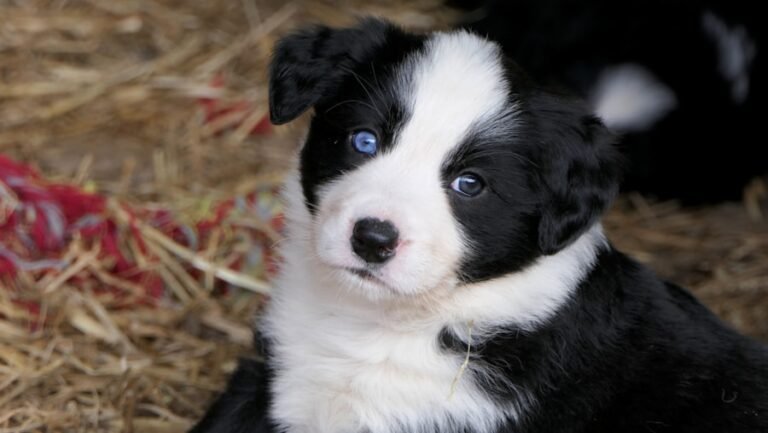Border Collies Blue Merle: Understanding Their Unique Coloring
Are you a fan of Border Collies and you may be particularly drawn to the Border Collies Blue Merle variety? These dogs are beloved by many for their unique coat pattern and playful personalities. In this blog post, we’ll dive into everything you need to know about them – from their origins and genetics to health concerns and training tips. Get ready to fall in love with these fascinating canines!
History and Origins of Border Collies Blue Merle
Border Collies have been a popular breed for centuries, but their blue merle coloring is more recent. The breed originated in the border regions of Scotland and England, where they were primarily used as working dogs on farms to herd sheep.
Border Collies’ blue merle pattern remains unknown, though its source could possibly lie elsewhere, such as Australian Shepherds or Shetland Sheepdogs, before becoming part of their bloodline by breeding.
One theory holds that the blue merle pattern was established through breeding tricolored Border Collies with solid-colored dogs like black-and-white or red-and-white. Over time, puppies with distinctive combinations of colors began appearing – including those sporting striking blue-grey coats speckled with black spots.
Today, Blue Merle Border Collies continue to be popular not only for their stunning appearance but also for their intelligence and strong work ethic. They are often utilized on ranches and farms across North America herding livestock like cattle and sheep.
Characteristics of Border Collies Blue Merle
Border Collies with a blue merle coat are known for their distinct and striking appearance. They have a mottled or marbled pattern of silver, black, and gray that appears as if it has been painted on their fur. But aside from their unique appearance, what other characteristics do they possess?
Blue Merle Border Collies are highly intelligent dogs that excel at various activities such as agility training, flyball competitions, obedience trials and herding competitions. Due to their intelligence they make highly trainable companions – something police departments often exploit as part of their search-and-rescue missions.
In terms of temperament, Blue Merle Border Collies pack high energy levels-which make them great pets for people who love outdoor activities like hiking or running. However, this also means they need plenty of physical activity to keep them stimulated mentally and physically.
One thing worth noting is that while these dogs can be affectionate towards their owners; they tend to be reserved around strangers until they get comfortable with the person- so socialization at an early age is crucial.
Blue Merle Border Collies possess both beauty & brains making them not just gorgeous but also great companions who thrive with consistent training & exercise!
Genetics of the Blue Merle Pattern
The blue merle pattern in Border Collies is a fascinating genetic occurrence that produces their stunning appearance. This distinctive coat color arises from the interaction of two distinct genes: the Merle gene and genes dictating black or brown pigment distribution.
The Merle gene is responsible for creating a marbled or patchwork effect on the dog’s coat, diluting portions of it to lighter shades. It results in an eye-catching mix of dark and light patches, giving rise to the unique blue merle coloring.
In contrast, pigment distribution genes determine whether a dog will have black or brown-based fur. When these two sets of genes work together, they create various patterns and combinations within the breed.
It is essential to note that breeding two dogs with merle coats can lead to health risks for their offspring due to potential complications caused by homozygous merle inheritance (double-merle). Therefore, responsible breeding practices should always prioritize maintaining healthy genetics over solely focusing on achieving specific aesthetics in future generations.
Understanding this intricate genetic interplay helps us appreciate not only why each blue merle Border Collie has its own unique look but also highlights the importance of ethical breeding practices within this beloved breed.
Health and Care
Border Collies Blue Merle are generally healthy dogs that can live up to 12-15 years with proper care. However, like any other breed, they may develop certain health issues.
Border Collies Blue Merle are prone to certain health problems, such as deafness and eye disorders.
Maintaining their hearing by visiting a veterinarian regularly, and their eyes examined by an ophthalmologist as part of an overall wellness strategy is also essential to ensure they remain healthy. Furthermore, providing them with a balanced diet and plenty of physical exercise will only serve to further safeguard their wellbeing.
Grooming your pet on a regular basis is also key for keeping their coat looking its best and preventing tangles or mats from forming, so brushing them two to three times every week should keep their coat in peak condition.
Make sure your dog receives all necessary vaccinations and preventative treatments against parasites such as worms, fleas, ticks etc., according to your vet’s recommendations.
By providing proper care for your Border Collie Blue Merle you can ensure they live a happy healthy life by your side!
Training and Temperament
Training and temperament should both be key components when considering ownership of a Border Collie Blue Merle. These dogs are known for being highly intelligent, energetic, and thrive off mental stimulation.
When training your Border Collie Blue Merle, it’s essential to use positive reinforcement methods. This means rewarding good behavior with treats or praise rather than punishment for bad behavior.
Socialization is also essential to these dogs as they may become wary of strangers if not properly introduced. Children should be exposed to different people, environments, and animals from an early age so they learn how to adapt and feel secure in different situations.
Due to their high energy levels, regular exercise is crucial for Border Collies Blue Merle. An hour of physical activity per day is recommended along with mental stimulation through activities such as agility training or puzzle games.
It’s worth noting that this breed thrives on having a job or purpose – whether it’s herding livestock or learning obedience skills. Without proper engagement and training, they may become bored and develop undesirable behaviors like excessive barking or destructive chewing.
The key to successfully training a Border Collie Blue Merle lies in providing them with plenty of opportunities for exercise, socialization, mental stimulation, positive reinforcement techniques while being patient throughout the process.
Conclusion
After exploring the history, characteristics, genetics, health and care, as well as training and temperament of Border Collies Blue Merle in this blog post, it is safe to say that these dogs are truly remarkable. Their intelligence and athleticism make them great companions for those who lead active lifestyles or have a job for them to do.
However, owning a Border Collie Blue Merle comes with its own set of challenges. These dogs require plenty of exercise and mental stimulation to avoid destructive behaviors. Additionally, potential owners should be aware of the risk of health issues associated with the blue merle gene.
Invest the time and energy necessary to care for a Border Collie Blue Merle properly, and you will reap incredible rewards in terms of companionship! Just remember that each dog has his/her own individual personality and needs; take the time to get to know your furry pal!
FAQs
1. Are blue merle Border Collies rare?
Yes, blue merle Border Collies are relatively rare compared to other coat colors. They are bred less frequently and can be more difficult to find.
2. Do blue merle Border Collies make good family pets?
Yes, if given the appropriate amount of exercise and mental stimulation, blue merle Border Collies can make excellent family pets. However, their high energy levels and intense herding instincts may not be suitable for all households.
3. Can you train a blue merle Border Collie as a working dog?
Absolutely! Blue Merles have been known to excel in various roles including herding livestock or competing in sporting events such as agility competitions.
4. How often should I groom my Blue Merle Border collie?
Border collies require regular grooming sessions due to their thick double coats which they shed twice a year heavily; brushing at least once or twice weekly is recommended.
5. What health issues are common among border collies Blue Merles
Blue Merles could suffer from several genetic illnesses like hip dysplasia, cataracts and deafness; thus it’s important that breeders test parents before breeding them together so that these conditions do not further spread through the gene pool.
Owning a border collie with a beautiful blue-merle coat color can bring joy into your life but it also requires proper care and attention like any other breed does – don’t forget about their energetic nature! As long as you provide plenty of opportunities for exercise, training, socialization along with love & affection your furry friend will surely thrive by your side for years to come!








